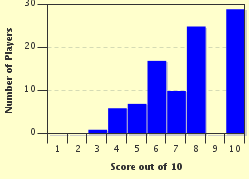
Those Cute Downy Hatchlings! Trivia Quiz
Are all baby birds cute? Certainly beauty is in the eye of the beholder. There is no doubt, however, that they are all downy! Can you match these bird babies with the correct adult name?
A matching quiz
by ponycargirl.
Estimated time: 4 mins.
- Home
- »
- Quizzes
- »
- Animal Trivia
- »
- Wild Birds
